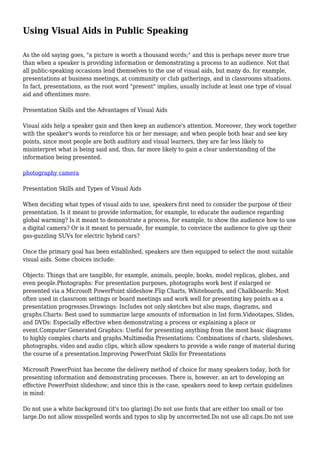
Using Visual Aids in Public Speaking
- 1. Using Visual Aids in Public Speaking As the old saying goes, "a picture is worth a thousand words;" and this is perhaps never more true than when a speaker is providing information or demonstrating a process to an audience. Not that all public-speaking occasions lend themselves to the use of visual aids, but many do, for example, presentations at business meetings, at community or club gatherings, and in classrooms situations. In fact, presentations, as the root word "present" implies, usually include at least one type of visual aid and oftentimes more. Presentation Skills and the Advantages of Visual Aids Visual aids help a speaker gain and then keep an audience's attention. Moreover, they work together with the speaker's words to reinforce his or her message; and when people both hear and see key points, since most people are both auditory and visual learners, they are far less likely to misinterpret what is being said and, thus, far more likely to gain a clear understanding of the information being presented. photography camera Presentation Skills and Types of Visual Aids When deciding what types of visual aids to use, speakers first need to consider the purpose of their presentation. Is it meant to provide information, for example, to educate the audience regarding global warming? Is it meant to demonstrate a process, for example, to show the audience how to use a digital camera? Or is it meant to persuade, for example, to convince the audience to give up their gas-guzzling SUVs for electric hybrid cars? Once the primary goal has been established, speakers are then equipped to select the most suitable visual aids. Some choices include: Objects: Things that are tangible, for example, animals, people, books, model replicas, globes, and even people.Photographs: For presentation purposes, photographs work best if enlarged or presented via a Microsoft PowerPoint slideshow.Flip Charts, Whiteboards, and Chalkboards: Most often used in classroom settings or board meetings and work well for presenting key points as a presentation progresses.Drawings: Includes not only sketches but also maps, diagrams, and graphs.Charts: Best used to summarize large amounts of information in list form.Videotapes, Slides, and DVDs: Especially effective when demonstrating a process or explaining a place or event.Computer Generated Graphics: Useful for presenting anything from the most basic diagrams to highly complex charts and graphs.Multimedia Presentations: Combinations of charts, slideshows, photographs, video and audio clips, which allow speakers to provide a wide range of material during the course of a presentation.Improving PowerPoint Skills for Presentations Microsoft PowerPoint has become the delivery method of choice for many speakers today, both for presenting information and demonstrating processes. There is, however, an art to developing an effective PowerPoint slideshow; and since this is the case, speakers need to keep certain guidelines in mind: Do not use a white background (it's too glaring).Do not use fonts that are either too small or too large.Do not allow misspelled words and typos to slip by uncorrected.Do not use all caps.Do not use
- 2. a wide variety of fonts; instead, limit the number to two at most.Do choose colors carefully; dark lettering on a light (but not white) background usually works best.Do present information in bulleted points, not complete sentences.Do limit bulleted points to a maximum of six per slide.Do use graphics but only if they are relevant to what is being said.Do organize slides based upon the order in which information will be presented.Tips for Effectively Using Visual Aids Although the choice of visual aids is important, how those aids are used is perhaps even more important. After all, a speaker can have phenomenal visual aids, but if they are not displayed properly, discussed clearly and effectively, and integrated smoothly into the presentation, they will be of little or no value. In order to get the maximum impact with visual aids: Talk to the audience, not to the PowerPoint slideshow, the flipchart, or the whiteboard.Avoid passing objects, photographs, handouts, etc. around among audience members (It takes their attention off what is being said).When displaying an object, place it where everyone can see it; and display it only when discussing it.Clearly and concisely explain the information contained on any visual aid.Practice using visual aids in advance of the actual presentation. In fact, speakers should rehearse the entire presentation, from start to finish, so they will be able to integrate visual aids smoothly, effortlessly, and professionally.Indeed, a picture is worth a thousand words, which is why it is advantageous for speakers to learn not only how to create effective visual aids but also how to use them expertly during the course of a presentation. Reference: Lucas, S. (1998) The Art of Public Speaking: Sixth Edition. Boston: McGraw-Hill http://suite101.com/using-visual-aids-in-public-speaking-a145282